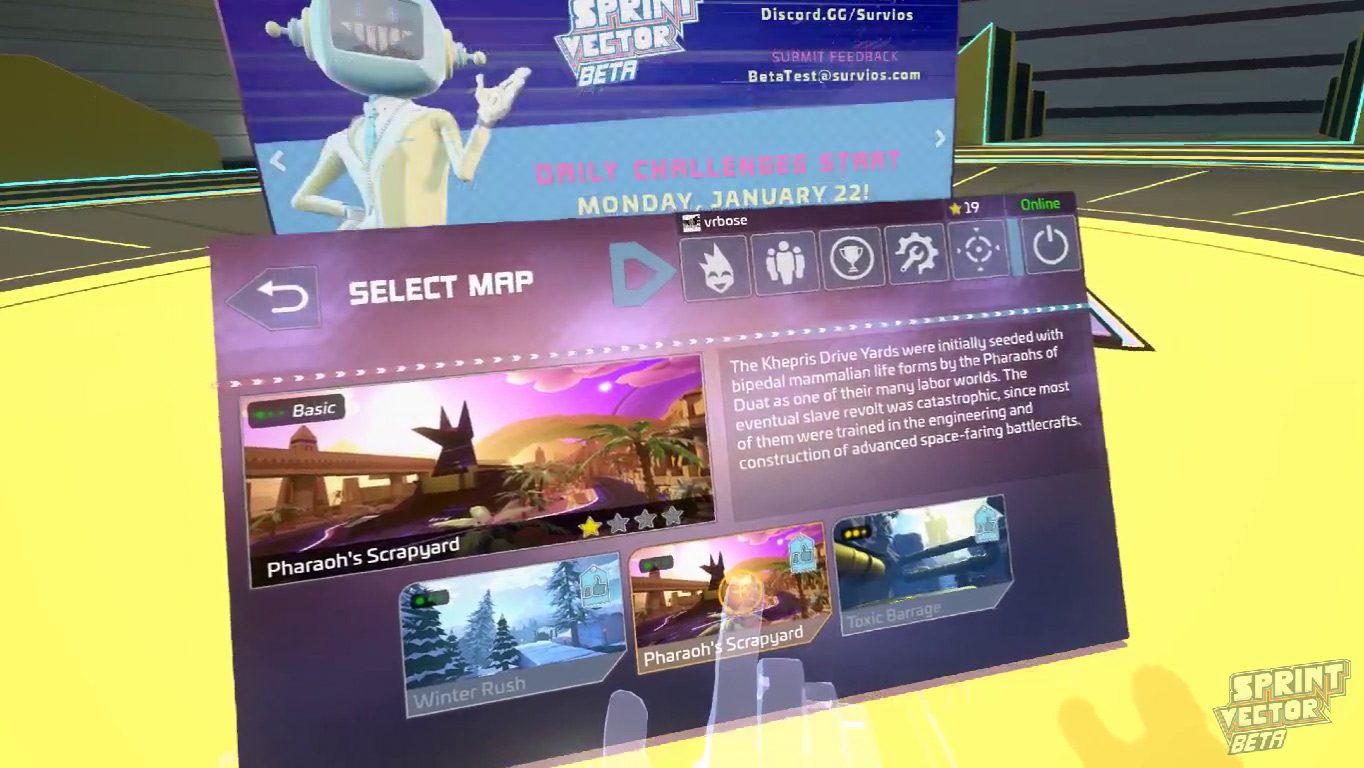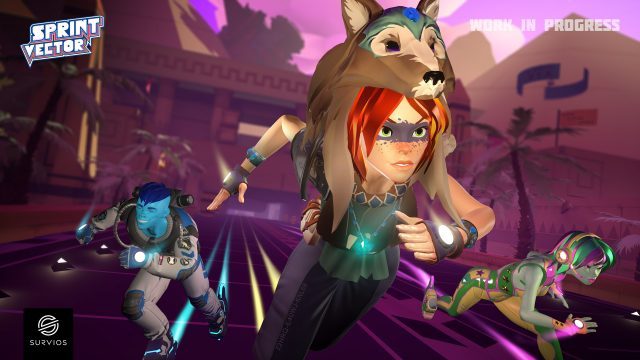Sprint Vector, the upcoming VR footracing game from Raw Data (2017) studio Survios, went into closed beta last week. Now with a few multiplayer matches under my belt and a number of solo challenges (and possibly some overextended elbows), it’s clear the studio’s so-called “adrenaline platformer” is aiming to impress with a number of new modes, some new mechanics and a thick coat of polish.
I’ve had the opportunity to play Sprint Vector multiple times since it was first debuted at GDC last year. Every time I approached it, I got a little less horrible at drifting through the cartoonish courses. I was always relegated to playing head-to-head with a far too lenient handler or developer though, who more often than not were more concerned with showing me the ropes than punishing me outright. Now, having played what could easily be mistaken for a consumer-ready game, I am humbled.
The closed beta featured three solo challenge maps with three modes each, and three competitive maps which could either be played solo vs AI, or in an 8-player online race.


Having played a few times before, I thought I was clear to skip the tutorials and head straight into my first competitive race. Boy, was I wrong. Landing second to last, and seeing my fellow racers finish the course way before me, I decided to go back to the basics for fear of missing something important. Divided into three sections—basic, intermediate, and advanced—there’s plenty to learn when it comes to mastering the locomotion system in Sprint Vector; you have to skate, drift, jump, fly, climb – all while keeping an eye on your opponents.
Instead of hitting the multiplayer mode again (fool me once), I started out fresh from the tutorial on the newly revealed solo challenge maps.
While there are only three right now—Driftway – a deceptively simple beginner track, Killer Boost – a track littered with boosts and tons of jumps, and Sidewinder – a ‘grip stream’ nightmare—it was easy to lose a good chunk of time playing each of these through their three different modes: time trial, coin collection, and hardcore one-life. Hardcore one-life pumps you full of nitro so you never stop moving forward at high-speed, meaning you have to dial in on your steering, shooting and flying to get the best time.
I could easily spend time honing my skill to climb the respective leaderboards, but even after polishing for an hour, it became clear that I simply wasn’t anywhere near good enough yet to post any meaningful result on the challenge board, not yet at least.
Returning to the ‘skate park’, or the lobby filled with air boosts and grip streams, I spent some quality time pumping my arms, diligently playing attention to the speed meter at my lower register. Soon enough, after some more practice, I was getting some momentum to my strides, releasing the trigger button just as I pumped my arm down to my hip.
Now after some bonafide training, I was ready for my first multiplayer. This time I hit my strides correctly, picked up my power-ups and traps (just like in Mario Kart) and finished in a respectable third place. I got a chance to use the game’s weapons for the first time too – a standard mix of missiles, nitros, and slowdown traps that come part and parcel with these sorts of arcade racers.
It’s clear there’s still a lot to learn about each course and how to best attack it, but I felt I’d finally understood how to move in the world and have that 1:1 physical engagement with my surroundings. The wizards over at Survios have certainly boned up on their Oculus Best Practice Guide too, as it felt completely nausea-free throughout.
Interesting side note: I got a chance to prove to myself just how much of a workout the game really is. According to my Fitbit, I have an average resting heart rate of around 50-60 beats per minute (bmp). While playing Sprint Vector however, the heart rate monitor told me I had entered into the ‘fat burn zone’ for nearly 20 minutes, with my heart rate jacking up to over 94 bmp. If my heart pumped any faster (over 131 bmp), I would have inched into the ‘Cardio zone’.
There was one unfortunate side effect after playing a straight hour of multiplayer: tennis elbow. It seems during my quest to do my best, and pump my arms like crazy, I was overextending the joints in my elbow with my feverish downstrokes, leaving the telltale pain that I had felt back in high school when I was into karate. While it’s not a show stopper, I’ll have to pay more attention to how I play from now on so I don’t develop the world’s first case of Sprint Vector elbow.
Sprint Vector feels and looks ready. And now that I’ve had my real training, I’m ready to head into the full version, which is slated to launch globally on Rift, Vive and PSVR in Q1 2018.

